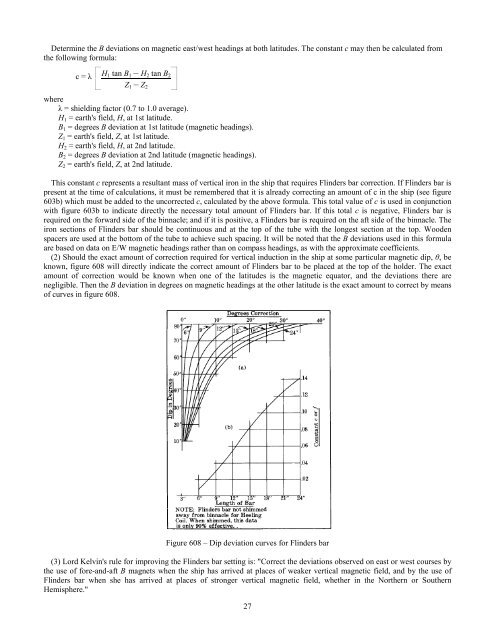Handbook of Magnetic Compass Adjustment - Maritime Safety ...
Handbook of Magnetic Compass Adjustment - Maritime Safety ...
Handbook of Magnetic Compass Adjustment - Maritime Safety ...
You also want an ePaper? Increase the reach of your titles
YUMPU automatically turns print PDFs into web optimized ePapers that Google loves.
Determine the B deviations on magnetic east/west headings at both latitudes. The constant c may then be calculated from<br />
the following formula:<br />
c = λ<br />
H 1 tan B 1 – H 2 tan B 2<br />
Z 1 – Z 2<br />
where<br />
λ = shielding factor (0.7 to 1.0 average).<br />
H 1 = earth's field, H, at 1st latitude.<br />
B 1 = degrees B deviation at 1st latitude (magnetic headings).<br />
Z 1 = earth's field, Z, at 1st latitude.<br />
H 2 = earth's field, H, at 2nd latitude.<br />
B 2 = degrees B deviation at 2nd latitude (magnetic headings).<br />
Z 2 = earth's field, Z, at 2nd latitude.<br />
This constant c represents a resultant mass <strong>of</strong> vertical iron in the ship that requires Flinders bar correction. If Flinders bar is<br />
present at the time <strong>of</strong> calculations, it must be remembered that it is already correcting an amount <strong>of</strong> c in the ship (see figure<br />
603b) which must be added to the uncorrected c, calculated by the above formula. This total value <strong>of</strong> c is used in conjunction<br />
with figure 603b to indicate directly the necessary total amount <strong>of</strong> Flinders bar. If this total c is negative, Flinders bar is<br />
required on the forward side <strong>of</strong> the binnacle; and if it is positive, a Flinders bar is required on the aft side <strong>of</strong> the binnacle. The<br />
iron sections <strong>of</strong> Flinders bar should be continuous and at the top <strong>of</strong> the tube with the longest section at the top. Wooden<br />
spacers are used at the bottom <strong>of</strong> the tube to achieve such spacing. It will be noted that the B deviations used in this formula<br />
are based on data on E/W magnetic headings rather than on compass headings, as with the approximate coefficients.<br />
(2) Should the exact amount <strong>of</strong> correction required for vertical induction in the ship at some particular magnetic dip, θ, be<br />
known, figure 608 will directly indicate the correct amount <strong>of</strong> Flinders bar to be placed at the top <strong>of</strong> the holder. The exact<br />
amount <strong>of</strong> correction would be known when one <strong>of</strong> the latitudes is the magnetic equator, and the deviations there are<br />
negligible. Then the B deviation in degrees on magnetic headings at the other latitude is the exact amount to correct by means<br />
<strong>of</strong> curves in figure 608.<br />
Figure 608 – Dip deviation curves for Flinders bar<br />
(3) Lord Kelvin's rule for improving the Flinders bar setting is: "Correct the deviations observed on east or west courses by<br />
the use <strong>of</strong> fore-and-aft B magnets when the ship has arrived at places <strong>of</strong> weaker vertical magnetic field, and by the use <strong>of</strong><br />
Flinders bar when she has arrived at places <strong>of</strong> stronger vertical magnetic field, whether in the Northern or Southern<br />
Hemisphere."<br />
27

















